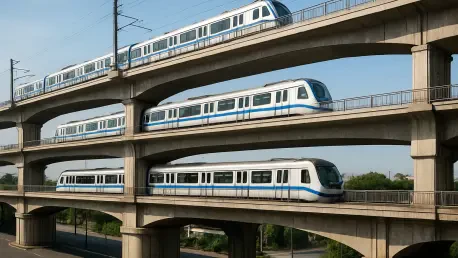In the heart of Chennai, a city pulsating with urban energy and grappling with the challenges of rapid growth, an extraordinary feat of engineering has emerged as a beacon of innovation. The Chennai Metro Rail Limited (CMRL) has achieved a groundbreaking milestone in Phase-II Corridor-4 at Vadapalani, crafting a tri-level metro viaduct that stands as a rare accomplishment in Indian infrastructure. This ambitious project, situated in the bustling Arcot Road area, navigates the complexities of limited space, active road traffic, and an operational elevated metro line. By seamlessly integrating advanced techniques and strategic planning, CMRL has not only addressed immediate urban transit needs but also set a new standard for metro projects in densely populated regions. This remarkable structure showcases how ingenuity can triumph over constraints, offering a glimpse into the future of sustainable urban mobility in one of India’s most dynamic cities.
Engineering Marvels in Urban Constraints
The construction of the tri-level viaduct at Vadapalani presented a unique set of challenges due to its location above an existing flyover and an operational metro line from Phase-I’s Corridor-2. Spanning a critical 45-meter obligatory section, the project demanded innovative solutions to avoid disrupting the daily flow of traffic and metro services below. Traditional crane erection methods proved unfeasible in such a confined and active environment, prompting CMRL to adopt the sophisticated Launching Girder methodology. This approach allowed for the precise placement of U-girders, ensuring safety and continuity of operations in a high-pressure urban corridor. The meticulous execution of this technique highlights how modern engineering can adapt to the most demanding conditions, providing a blueprint for tackling similar obstacles in other cities facing spatial limitations and the need for uninterrupted transit systems.
Beyond the innovative construction methods, the structural design of the viaduct itself stands as a testament to engineering excellence. A massive pier cap, measuring 23 meters in length, 10.46 meters in width, and 3.5 meters in depth, was crafted to support the critical span, weighing an astonishing 1,200 metric tons. Completed in a remarkably short span of two months, this component required seamless coordination among civil, electrical, and traffic management teams to ensure precision and efficiency. The ability to execute such a complex structure under tight constraints demonstrates not only technical prowess but also exceptional planning and interdisciplinary collaboration. This achievement underscores the potential for large-scale infrastructure projects to thrive in urban settings, where every inch of space and every minute of time must be meticulously accounted for to avoid broader disruptions.
Transforming Vadapalani into a Transit Hub
Vadapalani Metro Station has undergone a dramatic transformation with the integration of the tri-level viaduct, evolving into a vertically stacked transit hub designed to maximize efficiency in a densely built urban corridor. The station now features distinct levels for commercial retail, ticketing and concourse areas, and boarding platforms, each strategically organized to streamline passenger movement and enhance connectivity. This innovative design addresses the acute spatial challenges of the area, ensuring that the station serves as a pivotal junction for commuters navigating Chennai’s sprawling network. By optimizing vertical space, CMRL has created a model that not only meets immediate transit demands but also anticipates future growth, positioning Vadapalani as a critical node in the city’s metro system with improved access and flow.
The broader implications of this development extend to the entire Corridor-4, which stretches 26 kilometers from Light House to Poonamallee as part of Phase-II. This corridor aims to decongest arterial roads, connect western suburbs to vital commercial zones, and facilitate seamless interchanges with other metro lines. The tri-level structure at Vadapalani plays a central role in this vision, acting as a linchpin for integrating various transit modes while maintaining operational harmony in a high-traffic area. Such forward-thinking infrastructure reflects a commitment to enhancing urban mobility, reducing congestion, and fostering economic activity through better connectivity. The success at Vadapalani offers valuable lessons for other Indian cities striving to balance urban density with the need for efficient public transportation systems.
Setting a Benchmark for Future Projects
Reflecting on the completion of the Vadapalani tri-level viaduct, it is evident that CMRL’s innovative approach marked a turning point for metro infrastructure in India. The adoption of advanced construction techniques like the Launching Girder method, coupled with the rapid assembly of massive structural components, showcased a level of precision and coordination that was previously unseen in such constrained urban settings. Industry leaders, including prominent figures in urban infrastructure, hailed the project as a shining example of world-class engineering adapted to challenging environments. This endeavor not only met the immediate needs of Chennai’s growing population but also established a replicable framework for elevated metro projects in other high-density regions across the nation.
Looking ahead, the success of this pioneering structure paves the way for actionable strategies in urban transit development. Cities facing similar spatial and operational challenges can draw inspiration from CMRL’s methods, prioritizing advanced engineering solutions and cross-departmental collaboration to ensure project efficiency. Additionally, investing in vertical infrastructure designs, as demonstrated at Vadapalani, could help maximize limited urban space while enhancing passenger experiences. As metro systems continue to expand, adopting scalable models from this project will be crucial for sustainable growth, ensuring that future initiatives balance innovation with practicality to transform urban landscapes for the better.









